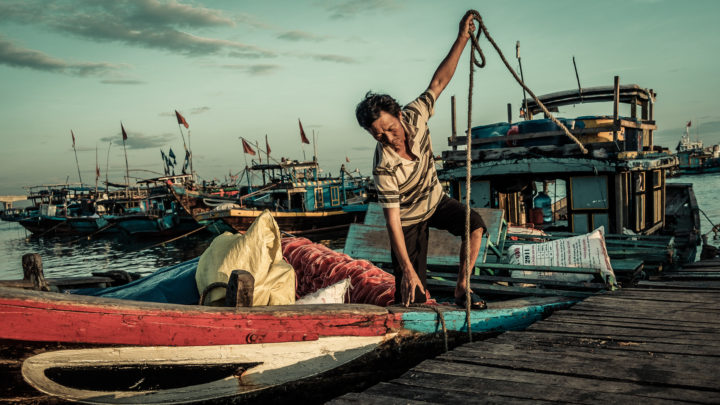Street and Travel Photography – A New Approach with Fujifilm
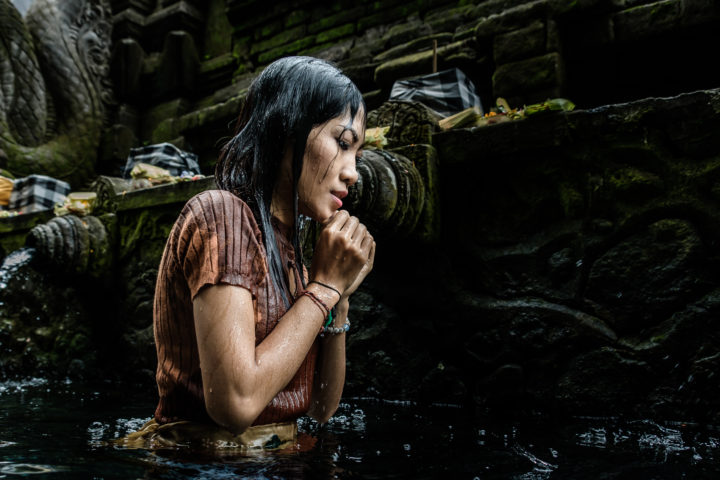
GUEST POST FEATURE
Write Your Articles Directly on FujiRumors!
Fergal McCleary
guest post by Philip Sutton: philipsuttonphotography.com + instagram at fineartfoto
I have too many years under my belt now to dare count them all. However, one thing that never fades with the decades is the memory of my wonderful childhood growing up in New Zealand. We were as poor as church mice, but my dad worked two jobs, so my sisters and I could have a wonderful upbringing. Aside from the trips to the lakes and wilderness areas of such a pristine land, the thing that burned deeply into the memory of my childhood, were the hours spent exploring and ‘plinking’ with my dubious friends on dad’s small hobby-farm. We would spend hours making wooden tree houses, collecting wild bird eggs and looking for rabbits and other critters. The one character in all of these escapades – who stood head and shoulders above the rest of us (not literally, but in legend status) – was Fergal McCleary.
Notwithstanding the many legendary stories surrounding Fergal – the one thing where he truly excelled, and made us all sick with envy – was his ability to ‘shoot from the hip’. We used to carry slingshots for our ‘plinking’ trips and target practice. We could shoot steel ball bearings straight through thick pieces of fibro cladding – like it wasn’t even there. We would practice for hours shooting tin cans and other targets in readiness to unleash ourselves upon the poor hapless critter population. No matter how much we practiced – nobody could ever beat Fergal McCleary. We mortal plebs had to hold the contraption up near our face or eyes to aim, but so often we would miss. Fergal had the uncanny knack of being able to hit almost anything – and very seldom ever miss – by shooting from the hip. He would just pull back at waist level and let the ball bearing fly – nine times out of ten he would hit the target.
On one occasion we disobeyed dad’s instructions, and went into the neighbour’s property. My dad had warned us to never go there, because the neighbour was well known for his unfriendly dogs. Like most things I never listened to my dad. In one adventure we ended up jumping over the neighbour’s fence, when suddenly we heard the deep, terrifying growl of an angry dog. By the time we turned to face the noise, here was a furious mongrel charging in our direction. We stood there riveted to the ground in fear, but not Fergal McCleary. In an instant he flicked up his wrist from waist level and ‘let fly’ with his slingshot. The steel ball found its mark, and the dog beat a hasty retreat. Fergal’s fame grew throughout the school yard, and nobody ever dared to get on the wrong side of Fearless Fergal McCleary. In fact, as the years grew and we moved on to high school some of the stories had become rather embellished. If Fergal is around somewhere – still telling his stories, I am sure the dog has grown into a rhinoceros and the rest of us were dwarfs and midgets!!
I am sure by now you are well and truly wondering what on earth I am on about, and what if any vague reference Fergal McCleary has to a photographic blog? In those dark and distant times, I was never able to challenge or even approach the prowess of Fergal McCleary, when it came to shooting from the hip. Well I want it to be known at this juncture, that by the time I have completed this blog, I will be known as the Fergal McCleary of the photographic world – oh yes – He who shoots from the hip!!
Where it all began
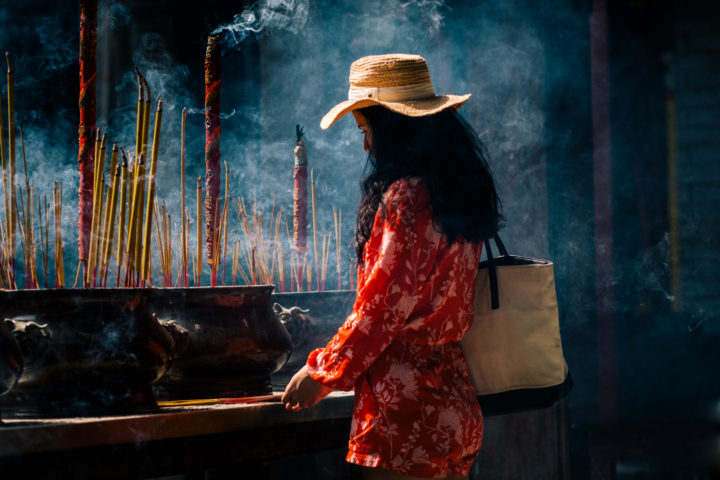
I cut my teeth in photography during the film era shooting stock for a stock library called Astral International (now Austral Press). Unlike today, where you may only get a few cents for an image, there was very good money to be made in stock photography. Moreover, film was a lot more demanding and cameras were still quite expensive. Not everybody had a camera, and even less were vying to be published or recognised, or even more to the point – had the skills to do so. I am so glad that I learned the basics of the industry by shooting film. For various reasons, I had a long sabbatical from photography for over 10yrs. When I finally returned to the ‘fold’, things were well and truly cemented in the digital arena, and oh how things had changed in the commercial world. I tried breaking back into stock and realised that one hundred thousand people had already beaten me to it!
The stock that had been very successful for me prior was agricultural photography. Many of my images were used for school text-books (Geography), and advertising brochures. The images that were most successful were a serious of images I had taken of sugarcane harvesting in Queensland. The lovely green sugarcane, contrasted against the deep blue skies – all shot on Fujichrome – these were very presentable images. I also noticed that images with people were usually more likely to be purchased, than the images that were purely landscapes or sceneries. My portfolio included two old timers cutting sugarcane by hand. I had the wide-angle lens up close, almost in their faces, with the blurred swish of the cane-knife, contrasted with the rich green cane and blue skies behind them. They had the black from the charcoal all over their faces (they burn the cane before they harvest it), and their hardened, shirtless bodies were bathed in sweat. These images were hugely successful and kept me in ‘pocket money’ for a very long time (I still worked as a teacher – the ‘stock’ was only a hobby).
Therefore, when I got back into photography in the new Millennium and found that ‘stock’ was not as lucrative and now a very hard nut to ‘crack’ I naturally moved toward photographing people through the genre of ‘street’ and environmental portraiture. I couldn’t be bothered with all the hoops I had to previously jump through with ‘stock’, I just wanted to get out and shoot the random ‘dailiness’ of life for the pure artistic joy of it all. However, I instantly realised I had a very big problem. The thing with stock photography was that my shoots were usually organised and setup before hand. Permission was asked and models or friends were happy to be photographed and to sign a model release. The difference now was that the people I was pointing my camera at, were random folk on the street, all going about their ‘dailiness’ and completely unaware that they now needed to be photographed!! No permissions had been asked, no model releases signed and they were certainly not aware of what I was doing. I had not been used to this in the stock world. Even though I really enjoyed some of the images I was getting, it was rather harrowing having to point my big camera at the poor hapless crowd in the street.
The beginnings of a new way to ‘see’
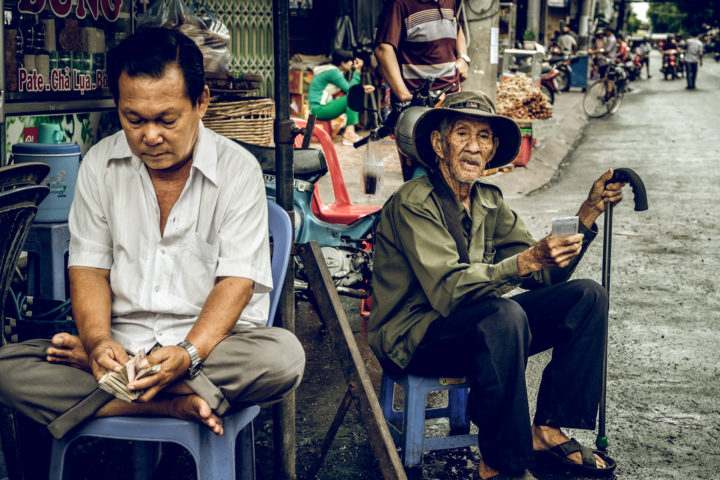
I would get a lot of frowns, funny looks, people wondering what on earth I was doing and lots and lots of “no”! I found that I was going out less and less with my big Nikon DSLR and huge 70-200mm, or wide angle zoom lens. It also happened at the same time that the weight of this system was starting to drag me down on my long, hot trips to Asia. This is all discussed in detail in my blog ‘Fujifilm – my journey from frustration to competency’, but suffice to say, I started swapping over to a smaller, lighter system and ended up settling on Fuji Mirror-less. I remember the first day I went out with my new X-T1, and having decided to try this fiddly looking flippy screen on the back – I had stumbled upon something magic. I did not have to lift my camera up to my eye to take a photo. I could look down and shoot at waist level. Moreover, I started to notice that people paid far less attention to me – I was basically ignored as I apparently fiddled with my camera controls, looking down and not at or into people’s eyes. This was truly one of those ‘eureka moments’ that we read about.
These were the seeds of the new MO (modus operandi) that I developed, and it has grown and evolved into how I operate now and how I get the images that I do. The most important thing I noticed was that I was no longer an imposter in people’s worlds. Humans have an incredible built-in radar, that subconsciously knows each time a camera is pointed at them. I have tried this over and over again. You can stand quietly on the street, or in an industrial area where I often shoot people working, and watch somebody working or doing what they do – for a very long time. They will usually just ignore you and carry on with what they are doing. However, as soon as you lift a camera up to your eye, and point it at them – whammo – they know in an instant, and they have you ‘nailed’. This was the one thing that always made me feel like an imposter – and I hated it. I loved taking my street photos, I loved the images I took, but I wrestled long over the fact that I was an imposter in people’s worlds, and I disturbed the equilibrium of the community, or street or wherever I was.
This all changed when I adapted my new style of shooting using Fuji Mirrorless, and implementing the flippy screen on the back of the camera. It slowly morphed over the last few years, until I now have a totally different style and approach to what I had with the Nikon cameras, and I feel so much more comfortable, and much less an intruder into people’s lives.
My Modus Operandi!
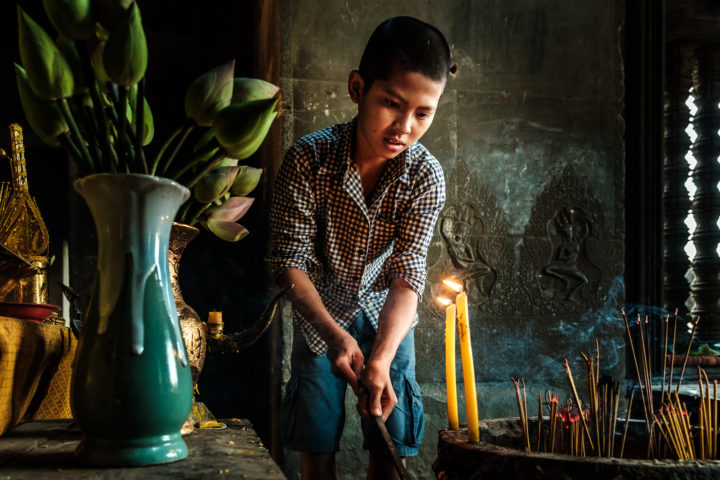
The first thing to remember is to be relaxed. People pick up on vibes, so I always appear friendly and approachable, and I just kind of ‘mooch’ slowly along. Clothing is very important too. You can’t wear a white or brightly coloured shirt at all. On a sunny bright day, when you are looking down at the screen (waist level), the white from your shirt reflects straight into the screen and you can’t see a wretched thing (I found this out the hard way). I usually wear my favourite jeans and a cool, long-sleeve shirt (keeps the sun off my arms). I always wear black leather gloves – they keep my sweaty paws from destroying the imitation leather on the cameras (it really works), and the blazing sun off the back of my hands. I wear a brightly coloured bandana around my head – this keeps the sun off my face and keeps the sweat away on a hot day (it’s always hot in Asia – he he). I kind of stick out like the ‘proverbial’ you know what, but I think that is a good thing. The places I usually shoot in, I’m mostly always the only white man there (except when I shoot in my own country), so I figured no matter how I dress, I will always be ‘pinged’ long before I take any photos. My style of dress makes me unique and I often get a few laughs from people and it works for me. It’s not the clothing we wear or don’t wear that makes us conspicuous when we are shooting, it is the style of photography that we adapt, and I’m about to get very specific about this now.
It is at this point I want to emphasise the one major change that you will need to make for this style to be successful for you. It is counter-intuitive and goes against everything we have ever been taught or told about street photography. I have read countless blogs and seen many videos on YouTube all regarding the different styles and means that we can adapt to become successful street and environmental photographers. Many of them tell you to ask permission – oh my goodness that is the worst thing to do if you want to catch that special moment and avoid getting a ‘canned’ shot. Yes people are usually very lovely and gracious – if you ask permission you will probably get it – but say goodbye to the world of special ‘moments’ and say hello to the world of record shots. I will allude to this further under my heading ‘Never lower your standards’ and explain that like everything there is the odd exception to this rule. However, if you really want to catch that magic moment – never ask for permission.
Never to be Forgotten
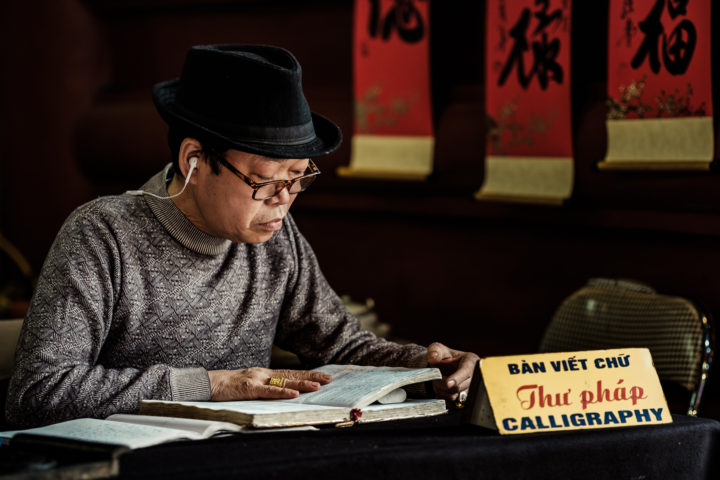
Furthermore I have never read one blog or listened to one video where they have made this point – (here it comes – never forget it), no matter what you do Never Ever make eye contact. If you make eye contact you have already ruined nearly all of your chances to get the ‘moment’. They now know that you know that they know. In other words, once they know that you have zeroed in on them with your eyes, they are aware that you have singled them out – stalking them for a shot perhaps? They will now watch you very closely and every move you make – the fact that you know that they now know – just changes the balance in the whole scenario. You have just basically lost all your chances of pulling off that magic ‘moment’. If you now attempt to lift the camera to your eye or take a photo, they fully have you ‘pinged’! This is not idle talk. I have been traveling and taking street/candids/environmentportraits abroad and at home now for well over 12 years. I have tried this dozens of times. When you make eye contact with a person you kind of make an unwritten contract – you have seen them, they have registered the fact that you have seen them – now the next move is on you. What are you going to do next??
Remember when you were a kid?? I grew up in a pretty rough part of New Zealand. I have always been skinny and scrawny (the 7 stone weakling – ha ha) – no matter what age I was or at what stage of life I choose to remember, I was always the one who was going to be picked on or bullied. A lot of my peers and contemporaries (and close friends) at school were Maori and Polynesian. These boys are huge and most of them were twice my size (have a look at the New Zealand All blacks Rugby Team)!! I had to walk through an isolated farming area to get to and from high school. I learnt the hard way back then that if you looked at some of the big kids on the way home, then you were in big trouble – yes, just simply looked at them!! The cry would go out “…. what the hell are you looking at Pakeha” (‘Pakeha’ is the Maori word for White Man)?? Then you would have lots of explaining to do in order not to have your butt whipped (back then it was called getting your ‘beans’). Conversely, if I kept myself to myself and looked at the ground and made no eye contact, then I usually avoided getting my ‘beans’! Taking photos is no different – no eye contact means you don’t owe anybody any explanation and there is no focus of attention on you and people will not be wondering what will you be doing next – period!!
This ‘battle’ of who is going to do what next all changed the day I experimented and made my photos with NO eye contact at all. Whammo – it changed the whole scenario. If you don’t make eye contact then you have not even made the first step that would normally be taken in obtaining a photo. You have not registered the fact that you are even remotely interested in them. You are just somebody in the crowd or somebody wandering past.
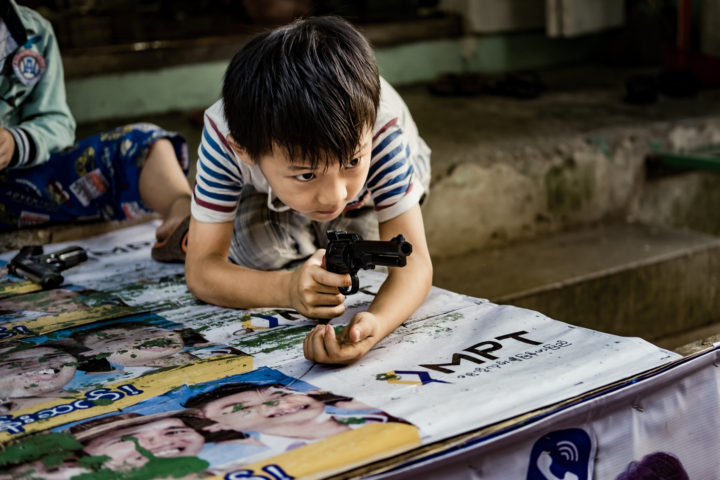
Now here comes the second most important part to what I have been alluding to all along. My references to the ‘flippy screen’, my childhood tales of Fergal McCleary shooting from the hip – here is where it all comes together. These two magic halves of the equation – no eye contact, and shooting from the hip – combine to morph this new style into something quite magic and spectacular. Here now is how it all works – I just ‘mooch’ slowly along totally minding my own business. I don’t look at anybody or make eye contact. The flippy screen is pulled out horizontally on my X-T2 (or was my X-T1 prior to this). I am generally gazing around the scenery looking for my shot or a potential moment. Once I have spotted a potential shot, I start to move in that general direction. Remember – still no eye contact and never lift the camera to your eye. I am now honing in closer and shuffling over in that general direction. Usually always, because I have made no eye contact and I appear to just be gazing around, people are very relaxed and have no idea of what I am doing. Once I am close enough, I pay all of my attention into my flippy screen. I am now viewing my whole world through my flippy screen. Unless I am way back or honing in for a close-up portrait, I am always using my camera that has the magical 16-55 XF Fuji attached (oh boy – did I say I love this lens)? I can now zoom in a little bit or a little out to fill the frame of my shot. If I am very close and the sound of my shutter would give me away – I hit the magic ‘Q’ button and whack it onto Electronic Shutter – now I am totally silent. Remember importantly – still no eye contact has been made and to all the world I am just some idiot who is dressed really silly, shuffling along fiddling with his camera controls. By the time I have shuffled past, I could have taken 10-15 pictures – my ‘moment’ is in the bag and 95% of the time nobody even realises a picture has been taken.
The pictures I have chosen for this blog have all been shot from the hip with either my Fuji X-T1 or one of my current X-T2’s. I have also chosen these pictures because without this new style of shooting, none of these images would exist!! These were all situations that I had limited time to grab that special moment – then it was gone. Also, in most of these situations if I had even lifted the camera to my eye, the people would have frozen up and stopped what they were doing. Moreover, because I made no eye with anybody, the people paid no attention to me, and these beautiful images now exist to delight us all. Just as an aside – it is tragic that Fuji shot us all in the foot by releasing the new X-100F with no flippy screen – oh boy what on earth were they thinking of? This was totally idiotic because they market this camera as their main ‘street’ camera – WTH??? In other words if you are like me and you have one (X-100s for me) – leave it at home – it is useless!
Plan B
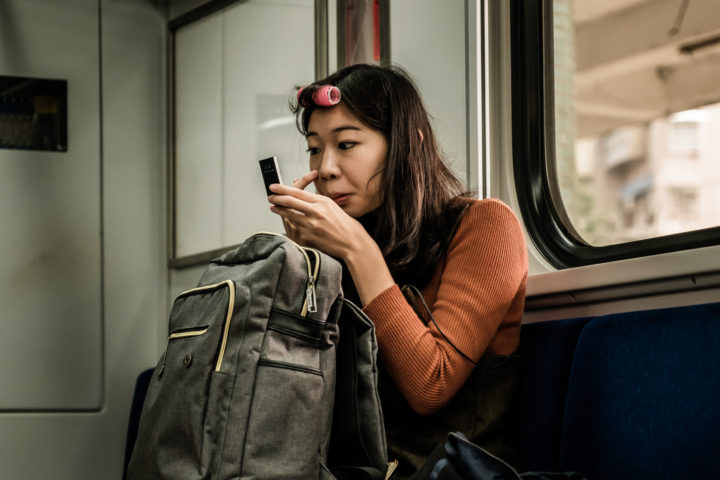
Oh my goodness – here is where I really get excited – I really love this part!! It’s like the part in the movie when all the plotting and plans of the good guy are discovered. He’s now in cuffs, shackled to the bomb in the basement, and it’s about to go off. Everybody thinks he is doomed and about to be turned into road-kill. Aaahh – but they all forgot about the plan B. Plan B means that unbeknown to everybody else, he had a secret up his sleeve. He put money in the bank when nobody was watching – he had his butt covered.
There are the odd times that my above method does not work. Not so much overtly so – but I just get a feeling that it is not appropriate to use that style. It is often when nobody else is around and I am the only one – then all of the attention is on me. My focus of interest is usually set up busking or doing something really interesting and I want to capture that ‘moment’. The problem is that even though I made no eye contact, or I have not lifted the camera to my eye – they still have me ‘nailed’. I can see out of my peripheral vision that if I look down and shoot from the hip, they will know and my moment will cease. If this happens – here is where plan B comes in. Without making any eye contact still, I just shuffle over and stand straight in front of the person or people or wherever I want to take my shot from. I now look above them and start ‘photographing’ something above and behind them (there is usually a tree or building or something I can point my camera at). They then avert their attention from me and usually have a quick look behind them to see what I am photographing. I use the camera at eye level now because I want it to be obvious that I am taking a shot.
What I do next is where the magic comes in. After I have taken my phoney shot, I now make it obvious that I am going to ‘chimp’. Everybody chimps these days so the person/people think you are just checking out the photo you took behind them. However, what I am actually doing is taking the real photo that I want. I hold the camera to eye level and look at the back of the screen apparently ‘chimping’ – but of course the camera is pointed at them. You only have to do this a couple of times and they ignore you, settle back into what they were doing best, and all those magic moments are there for the taking. Oh the magic of plan B. I actually use this method a lot and it really never fails. There are quite a few scenarios when my shooting from the hip is not appropriate, or I’m about to get ‘nailed’. I just swap over to plan B, and invariably the shot ends up in the ‘bag’!
Never lower your Standards
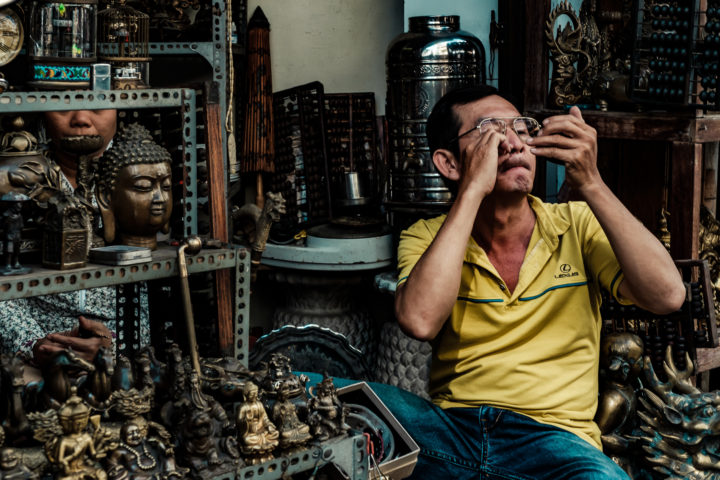
Here is where I can feel the temperature rising and now is the time to address it. Over the course of writing my blogs over the years – and alluding to this new style of shooting – I have had several people write to me and accuse me of being dishonest or being ‘sneaky’ and ‘stealing’ photos from people when they were unaware. I have actually read well on this subject and I know that in my country (I’m talking legally here – not morally), that it is legal to take photos of groups of people on the street or individuals in public areas. Of course where I shoot is usually always in a public area (unless I go into the brick factories or industry where I shoot in Asia – and permission has always been granted), and people are going about their general business. I know that the Asian countries I shoot in have the same precepts as here in Australia – in regards to taking photos in the street. However, they are extremely sensitive there around police stations, prisons and places where military families or Royalty may be present. Always exercise extreme caution in these circumstances. I have been in big trouble before and have had to extricate myself from some ‘hairy’ situations. These will be written about in detail in an upcoming blog.
You may notice I said ‘legally’! There are many times where it is legal to take a photo but not morally so. Here is where I want to emphasise that we need to set our moral standards high and never deviate from that. There have been lots of situations where I could have, but will never take a photo. I have seen some terrible accidents in Asia over the years – people half naked and groaning on the road in pain. Their countrymen usually always just stand around, often offer no assistance and take photos on their mobiles. I think this is disgusting to take photos of people’s extreme discomfort and pain, and like some voyeur, record it for whatever reason. I often see very unfortunate people with medical maladies on the street – things hanging off them, or shuffling along on their hands because their legs have been blown off. I never take photos of these people. Sometimes workmen or people on the street see me and they drag out their hapless friends – almost kicking and squealing – and hold them there for me to photograph. I will never take a photo of somebody’s discomfort or misfortune. My final screening method for shots of people that I put up on my website is “would I like to be photographed in that situation and have the whole world looking”? If I can say yes, then I use the picture, if I say no I would not like that, then the image is never put on public display. I think if you have a peek at the images on my website, you will see there are no pictures of people being humiliated or placed in compromising positions. If you are a decent person you will know where and when is the right time to take a photograph and use it. Disobey your own internal rules to your own demise!
I alluded to this above – there are also the odd times that asking permission is the best thing to do. When I am in a new town in Asia, I always track down the local brick factory, and head straight out there. Oh my goodness – there is nothing like a brick factory in Asia to get the best photos on earth. Smoke from the kiln, workers’ dirty faces, orange light from the clay reflecting everywhere – total magic. I have long ago been ejected from every brick factory here in my local area (don’t you hate all the silly rules we have here in the West), but I usually always get access to brick factories in Asia! However, you must be polite and ask for permission. It is a dangerous industrial site and you can’t go sneaking around hoping not to be seen. I’m sure there are other scenarios – if so, do the right thing and ask for permission!
Postlude
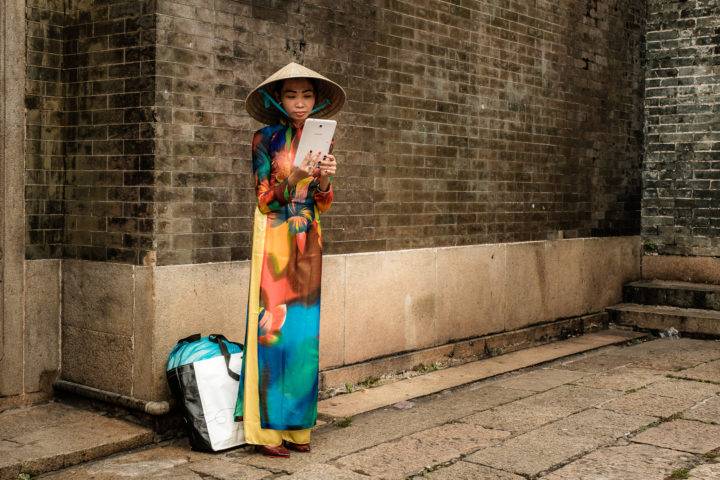
I am hoping that this has not been too longwinded or verbose for anyone – this was not my intention. However, I feel that this is an exact ‘science’ that I have been studying for many years. My hope is that I can impart this information to others and that this missive has been helpful and will open up an amazing adventure for you – to photograph the beautiful people of this world. Finally, if during the course of one of your adventures you find yourself out on the street and you spy a middle aged guy who is wearing black leather gloves, has a bandana pulled over his head, is looking downward apparently fiddling with something and is toting more cameras than a Texan tourist – you might want to sidle up to him and whisper “did you ever know Fergal Mccleary”?
Check out the rest of my pic’s on philipsuttonphotography.com
or catch me on Instagram – fineartfoto
